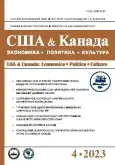Wind and solar energy effect in Canada
- Autores: Gazman V.D.1
-
Afiliações:
- National Research University Higher School of Economics
- Edição: Nº 4 (2023)
- Páginas: 94-107
- Seção: Economic Survey
- URL: https://journals.rcsi.science/2686-6730/article/view/144803
- DOI: https://doi.org/10.31857/S2686673023040077
- EDN: https://elibrary.ru/VGQXRW
- ID: 144803
Citar
Texto integral
Resumo
Sobre autores
Victor Gazman
National Research University Higher School of Economics
Email: vgazman@hse.ru
Moscow, Russian Federation
Bibliografia
- Газман В.Д. (2022) Потенциал возобновляемой энергетики: монография. ИД ВШЭ, Москва, Россия, 359 с. doi: 10.17323/978-5-7598-2573-9
- Смил В. Энергия и цивилизация: от первобытности до наших дней. М.: Эксмо, 2020, 480 с.
- Christoph Kost, Shivenes Shamugam, Verena Julch, NguenTran Nguen, Thomas Schlegl Levelized Cost of Electricity Renewable Energy Technologies. Freiburg: Fraunhofer Institute for Solar Energy Systems (ISE), 2018, March. 42 P. Available at: https://www.ise.fraunhofer.de/content/dam/ise/en/documents/publications/studies/EN2018_Fraunhofer-ISE_LCOE_Renewable_Energy_Technologies.pdf (accessed: 12.12.2022).
- Frank Ackerman (2007) Debating Climate Economics: The Stern Review vs. Its Critics Report to Friends of the Earth-UK - Global Development and Environment Institute, Tufts University, USA, July 2007. 24 P. Available at: https://www.bu.edu/eci/files/2019/06/SternDebateReport.pdf (accessed: 08.02.2023).
- Katharine Ricke, Laurent Drouet, Ken Caldeira, Massimo Tavoni (2018) Country-level social cost of carbon. - Nature Climat Change, 2018, Vol. 8, October. pp. 895-900. doi.org/10.1038/s41558-018-0282-y
- Mingweq Li, Da Zhang, Chiao-Ting Li, Kathleen M. Mulvaney, Noelle E. Selin, Valerie J. Karplus (2018) Air quality co-benefits of carbon pricing in China. - Nature Climate Change, Vol. 14, no. 8, pp. 398-403. (doi: 10.1038/s41558-018-0139-4)
- Nicholas Stern (2008) Key Elements of a Global Deal on Climate Change / The London School of Economics and Political Science. 2008. 56 P. https://doi.org/10.1073/pnas.1609244114 Available at: http://eprints.lse.ac.uk/19617/1/Key_Elements_of_a_Global_Deal-Final_version%282%29_with_additional_edits_post_launch.pdf (accessed: 12.12.2022).
- R. Daniel Bressler. The mortality cost of carbon - Nature Communications (2021) vol. 12: 4467 https://doi.org/10.1038/s41467-021-24487-w Available at: https://www.nature.com/articles/s41467-021-24487-w (accessed: 31.12.2022).
- Simon Dietz, Nicholas Stern (2015) Endogenous Growth, Convexity of Damage and Climate Risk: How Nordhaus' Framework Supports Deep Cuts in Carbon Emissions. - The Economic Journal, Vol. 125, no. 583, March 2015, pp. 574-620. (https://doi.org/10.1111/ecoj.12188).
- Simon Dietz, Nicholas Stern (2015) Endogenous Growth, Convexity of Damage and Climate Risk: How Nordhaus' Framework Supports Deep Cuts in Carbon Emissions. - The Economic Journal, Vol. 125, no. 583, March 2015, pp. 574-620. (https://doi.org/10.1111/ecoj.12188).
- William D. Nordhaus (2017) Revisiting the social cost of carbon. PNAS, National Academy of Sciences of the United States of America, January 31, 2017, pp. 1518-1523. Available at: https://www.pnas.org/content/114/7/1518 (accessed: 12.12.2022).
- W. Kip Viscusi, Clayton J. Masterman (2017) Income Elasticities and Global Values of a Statistical Life. Cambridge University Press, Journal of Benefit-Cost Analysis, 2017, Vol. 8, no 2, pp. 226-250. doi: 10.1017/bca.2017.12
Arquivos suplementares








